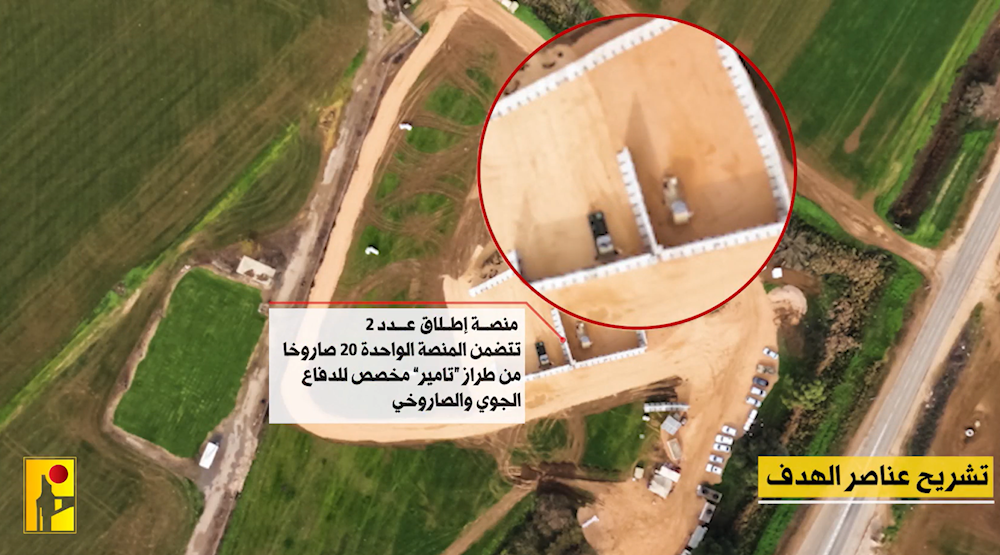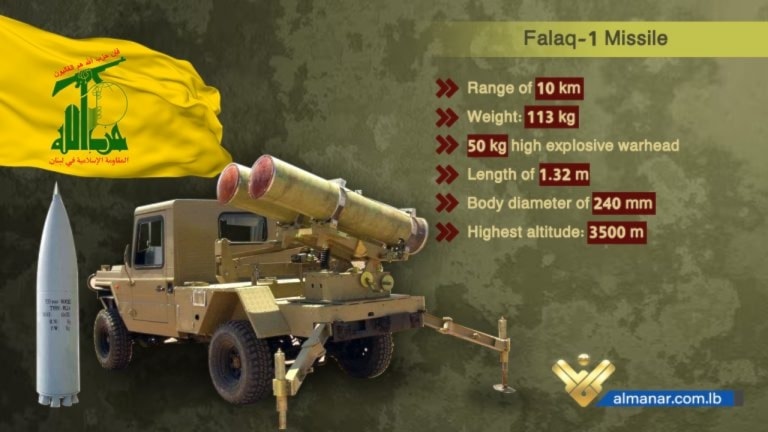Hezbollah unleashes Falaq-1, battle-tests new capabilities (Footage)
The Islamic Resistance in Lebanon targets multiple Israeli sites on Friday and releases footage of Israeli military positions it had obtained via a reconnaissance drone.
-

A screengrab from undated footage released by Hezbollah shows the moment a Hezbollah-operated drone located an Israeli Iron Dome system outside the "Kfar Blum" settlement in al-Jalil Panhandle, occupied Palestine. (Islamic Resistance in Lebanon/Military media)
In support of the Palestinian people and their Resistance, Hezbollah launched multiple attacks on Israeli military sites in occupied Lebanese and Palestinian territories on Friday.
Importantly, the Islamic Resistance in Lebanon announced that it used Falaq-1-type rockets to target one of the sites, which marked a first since Hezbollah launched its operations in support of the Palestinian people on October 8.
At 8:10 am, Hezbollah's fighters launched an attack on a grouping of Israeli occupation soldiers positioned in the vicinity of the Hounin Castle, using the appropriate weapons. The castle is located in the Israeli-occupied Lebanese town of Hounin in al-Jalil Panhandle.
Moreover, the group launched several attacks on the Israeli Barracks, "Ma'aleh Golan".
The Resistance said it launched the first attack on the Barracks, which is surrounded by multiple other military sites and military installations, at 1:00 pm (local time). Hezbollah fighters attacked the Barracks with multiple Falaq-1 rockets.
The second attack was launched at 4:10 pm (local time) and consisted of a "large barrage" of "Katyuhsa" rockets, a term that the Resistance uses to reference improved rocket artillery fired from multiple rocket launchers.
In this attack, Hezbollah fighters targeted several groupings of Israeli occupation soldiers located in the Barracks and its vicinity.
Later on Friday night, Hezbollah attacked a grouping of Israeli soldiers in the "Birket Risha" military site, confirming a direct hit on the soldiers at 9:00 pm.
Hezbollah snipers also fired at and destroyed recently installed Israeli spyware, in the "Zar'it" Barracks.
Shortly after, at 9:00 pm, the same Barracks came under attack with a Burkan rocket, and it was directly hit.
At 10:00 pm, a gathering of Israeli occupation soldiers on "Cobra Hill" was attacked with two Burkan rockets, achieving a direct hit.
Read more: Hezbollah's latest footage stuns Israeli media
What is Hezbollah's Falaq-1?
In its second attack of the day, Hezbollah officially debuted the Falaq-1 system for the first time in this round of confrontations. The weapon, developed by Iran's Aerospace Industries Organization, has a range of 10km and carries a high explosive warhead, weighing 50kg.
The surface-to-surface rocket can be launched from a multiple rocket launcher system installed on a light vehicle's cargo bed or from simple launch pads. Falaq-1 rockets have a 240 mm caliber and can be spin-stabilized if launched from the appropriate canisters, awarding them a maximum range of 10 km.
-

An infographic of the Falaq-1 rocket system (Al Manar)
A new version of the system had been recently released, marking improvements to the caliber and warhead of the system. The Falaq-2 is a 333 mm caliber rocket that carries a 120 kg improved warhead.
Al Mayadeen's sources confirmed that Hezbollah has owned the Falaq-1 system since the 1990s and has used it in operations leading up to South Lebanon's liberation in 2000.
Read more: Hezbollah publishes footage of targeting Israeli spying dome
2nd newly introduced weapon
It is worth noting that this is the second system that the Resistance has introduced to the front with "Israel" in the past two days. On Thursday, the group unveiled footage collected by a Television Camera installed on an Anti-Tank Guided Missile (ATGM). Unlike other ATGMs that the Resistance had heavily publicized in released footage, the latest video showcases an indirect mode of attack, which the system is capable of.
Just like the US-made Javelin, the Swedish-UK NLAW systems, and the Iranian Sadid-365 and Almas systems, the weapon engaged its target in the Jal al-Allam military site via a top-attack method, in which it flew at a low altitude for the majority of the flight before ascending to later quickly move in on its target. Importantly, the weapon unveils Hezbollah's ability to launch destructive attacks on Israeli targets from a three-dimensional scope, in contrast to traditionally employed weapons that offer a two-dimensional scope.
هذه هي المرة الأولى التي تستخدم فيها المقاومة هذا النوع من الصواريخ ذات طريقة الهجوم العلوي. المستخدم على ما يبدو قد يكون نوعا من صواريخ الألماس أو صديد ٣٦٥، ولكن بسبب شكل شاشة التهديف على الأرجح ألماس.
— Ali Jezzini (@Aly_jezzini) January 25, 2024
في التغريدة المقبلة صورة عن مهداف الألماس في أول فيديو تجريبي له منذ سنوات⬅️ pic.twitter.com/NAGpSxW2Ls
In other words, the group can now target Israeli forces and military equipment that are not in direct sight of fighters, using highly effective weapons.
The newly unveiled system relays real-time footage to the operators via the Television Camera, allowing Resistance fighters to accurately locate targets and steer the missile in their direction.
Sources informed on the matter told Al Mayadeen that "this is not the first time" Hezbollah uses the system, indicating that it has been previously deployed in combat situations previously. Moreover, our sources revealed that the missile is equipped with a thermobaric warhead, which results in extreme temperatures and pressure over a substantial area at its point of impact. Thermobaric warheads equipped on ATGMs have proven to be detrimental to both armored vehicles and infantry.
It is worth noting that the more commonly used Kornet, Malyutka, and Fagot systems can only directly attack targets within the visible of operators, through analog control or laser guidance.
Read more: Israeli 'Meron' base comes under Hezbollah attack for 2nd time
Hezbollah UAVs infiltrate enemy lines
On Friday evening, Hezbollah's military media also released footage that it had acquired via one of its reconnaissance drones. The drone flew from the direction of the Lebanese border town of Mays al-Jabal toward the "Kfar Blum" Israeli settlement into al-Jalil Panhandle.
⚡️WATCH: Hezbollah published a video showing aerial reconnaissance footages of the location it targeted in the Kafr Blum area, yesterday, targeting an Iron Dome platform.
— Arya - آریا 🇮🇷 (@AryJeay) January 26, 2024
The video explains that the AD platform is located 250m from the Kafr Blum settlement and contains 2 Iron… pic.twitter.com/HWKDaxm8L9
The drone, equipped with high-tech cameras, flew more than 6.5 km deep into enemy territories, going undetected by Israeli radars. Eventually, the drone reached an Israeli anti-air system located on the outskirts of "Kfar Blum", allowing the Resistance to gather precise information, including the location of a multiple missile launcher, which contains 20 tamir anti-air high-tech missiles.
The UAV was also able to detect a nearby Tamir missile storage depot and temporary operating rooms deployed in the area.
After collecting the information, Hezbollah launched an attack using two suicide drones on the Iron Dome system, confirming direct hits to the targets at 11:20 am on January 25, 2024.
Read more: Hezbollah continues operations against 'Israel' in support of Gaza

 6 Min Read
6 Min Read








